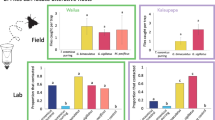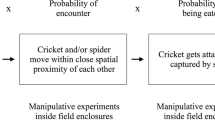Abstract
A possible parasitoid-evasion behavioral adaptation is examined in male field crickets, Teleogryllus oceanicus, from three Hawaiian islands where parasitoid prevalence varies naturally among islands. Ormia ochracea, the parasitoid fly that parasitizes T. oceanicus on these islands, uses male calling song to locate its hosts. We used laboratory-reared males from three Hawaiian islands to determine if there are population differences in the time it takes for calling males to resume calling after a standardized disturbance. Males follow the expected pattern; males from the island with the greatest risk of parasitism have the longest latency to resume calling, and males from the island with the least risk of parasitism have the shortest latency to resume calling. Results are discussed in the context of behavioral adaptations to differing parasitism levels, and trade-offs between natural and sexual selection.



Similar content being viewed by others
References
Adamo SA, Robert D, Hoy RR (1995) Effects of a tachinid parasitoid, Ormia ochracea, on the behaviour and reproduction of its male and female field cricket hosts (Gryllus spp.). J Insect Physiol 41:269–277
Banks PB (2001) Predation-sensitive grouping and habitat use by eastern grey kangaroos: a field experiment. Anim Behav 61:1013–1021
Bell PD (1979) Acoustic attraction of herons by crickets. J N Y Entomol Soc 87:126–127
Bentley D (1975) Single gene cricket mutations: effects on behaviour, sensilla, sensory neurons, and identified interneurons. Science 187:760–764
Bullock TH (1984) Comparative neuroethology of startle, rapid escape, and giant fiber-mediated responses. In: Eaton RC (ed) Neural mechanisms of startle behavior. Plenum, New York, pp 1–13
Cade W (1975) Acoustically orienting parasitoids: fly phonotaxis to cricket song. Science 190:1312–1313
Ciceran M, Murray A-M, Rowell G (1994) Natural variation in the temporal patterning of calling song structure in the field cricket Gryllus pennsylvanicus: effects of temperature, age, mass, time of day, and nearest neighbour. Can J Zool 72:38–42
Endler JA (1987) Predation, light intensity and courtship behaviour in Poecilia reticulata (Pisces: Poeciliidae). Anim Behav 35:1376–1385
Faure PA, Hoy RR (2000) The sounds of silence: cessation of singing and song pausing are ultrasound-induced acoustic startle behaviors in the katydid Neoconocephalus ensiger (Orthoptera; Tettigoniidae). J Comp Physiol A 186:129–142
Forsgren E, Magnhagen C (1993) Conflicting demands in sand gobies: predators influence reproductive behaviour. Behaviour 126:125–135
Gnatzy W, Kämper G (1990) Digger wasp against crickets. II. An airborne signal produced by a running predator. J Comp Physiol A 167:551–556
Gnatzy W, Heußlein R (1986) Digger wasp against crickets. I. Receptors involved in the antipredator strategies of the prey. Naturwissenschaften 73:212–215
Gras H, Hörner M (1992) Wind-evoked escape running of the cricket Gryllus bimaculatus. J Exp Biol 171:189–214
Gray DA, Cade WH (1999) Sex, death, and genetic variation: natural and sexual selection on cricket song. Proc R Soc Lond B Biol Sci 266:707–709
Hedrick AV (1986) Female preferences for male calling bout duration in a field cricket. Behav Ecol Sociobiol 19:73–77
Hedrick AV (2000) Crickets with extravagant mating songs compensate for predation risk with extra caution. Proc R Soc Lond B Biol Sci 267:671–675
Jennions MD, Backwell PRY (1992) Chorus size influences on the anti-predator response of a Neotropical frog. Anim Behav 44:990–992
Kanou M, Ohshima M, Inoue J (1999) The air-puff evoked escape behaviour of the cricket Gryllus bimaculatus and its compensational recovery after cercal ablations. Zool Sci 16:71–79
Kevan DKM (1990) Introduced grasshoppers and crickets in Micronesia. Bol San Veg 20:105–123
Kolluru GR (1999) The effects of an acoustically-orienting parasitoid fly (Ormia ochracea) on reproduction in the field cricket, Teleogryllus oceanicus: a trade-off between natural and sexual selection. PhD dissertation, University of California, Riverside, Calif.
Kumagai T, Shimozawa T, Baba Y (1998) Mobilities of the cercal wind-receptor hairs of the cricket, Gryllus bimaculatus. J Comp Physiol A 183:7–21
Lehmann GUC, Heller K-G, Lehmann AW (2001) Male bushcrickets favoured by parasitoid flies when acoustically more attractive for conspecific females (Orthoptera: Phanopteridae/Diptera: Tachinidae). Entomol Gen 25:135–140
Magnhagen C (1991) Predation risk as a cost of reproduction. Trends Ecol Evol 6:183–186
Martin SD, Gray DA, Cade WH (2000) Fine-scale temperature effects on cricket calling song. Can J Zool 78:706–712
Mason AC, Oshinsky ML, Hoy RR (2001) Hyperacute directional hearing in a microscale auditory system. Nature 410:686–690
Miller LA, Surlykke A (2001) How some insects detect and avoid being eaten by bats: tactics and countertactics of prey and predator. Bioscience 51:570–581
Müller P, Robert R (2001) A shot in the dark: the silent quest of a free-flying phonotactic fly. J Exp Biol 204:1039–1052
Müller P, Robert R (2002) Death comes suddenly to the unprepared: singing crickets, call fragmentation, and parasitoid flies. Behav Ecol 13:598-606
Pires A, Hoy RR (1992) Temperature coupling in cricket acoustic communication. J Comp Physiol A 171:69–78
Prestwich KN, Walker TJ (1981) Energetics of singing in crickets: effect of temperature in three trilling species (Orthoptera: Gryllidae). J Comp Physiol A 143:199–212
Rosenthal R, Rosnow RL (1991) Essentials of behavioural research: methods and data analysis, 2nd edn. McGraw-Hill, New York
Rotenberry JT, Zuk M, Simmons LW, Hayes C (1996) Phonotactic parasitoids and cricket song structure: an evaluation of alternative hypotheses. Evol Ecol 10:233–243
Sales G, Pye D (1974) Ultrasonic communication by animals. Chapman and Hall, London
Siegel S, Castellan NJ Jr (1988) Nonparametric statistics for the behavioural sciences, 2nd edn. McGraw-Hill, New York
Simmons LW, Zuk M (1994) Age structure of parasitized and unparasitized populations of the field cricket Teleogryllus oceanicus. Ethology 98:333–340
Spangler HG (1984) Silence as a defence against predatory bats in two species of calling insects. Southwest Nat 29:481–488
Wagner WE (1996) Convergent song preferences between female field crickets and acoustically orienting parasitoid flies. Behav Ecol 7:279–285
Walker TJ (1993) Phonotaxis in female Ormia ochracea (Diptera: Tachinidae), a parasitoid of field crickets. J Insect Behav 6:389–410
Zuk M, Kolluru GR (1998) Exploitation of sexual signals by predators and parasitoids. Q Rev Biol 73:415–438
Zuk M, Simmons LW, Cupp L (1993) Calling characteristics of parasitized and unparasitized populations of the field cricket Teleogryllus oceanicus. Behav Ecol Sociobiol 33:339–343
Zuk M, Simmons LW, Rotenberry JT (1995) Acoustically-orienting parasitoids in calling and silent males of the field cricket Teleogryllus oceanicus. Ecol Entomol 20:380–383
Zuk M, Rotenberry JT, Simmons LW (1998) Calling songs of field crickets (Teoleogryllus oceanicus) with and without phonotactic parasitoid infection. Evolution 52:166–171
Zuk M, Rotenberry JT, Simmons LW (2001) Geographical variation in calling song of the field cricket Teleogryllus oceanicus: the importance of spatial scale. J Evol Biol 14:731–741
Acknowledgements
We are grateful to the students who help maintain the cricket colonies. M.Z. was supported by grants from the National Science Foundation and from the Academic Senate of the University of California, Riverside, Calif. J. Calkins, S.N. Gershman, S.P. Scott, and A.M. Stoehr made useful comments on a previous version of the manuscript. The experiments described in this paper comply with the current laws of the United States of America.
Author information
Authors and Affiliations
Corresponding author
Additional information
Communicated by D. Gwynne
Rights and permissions
About this article
Cite this article
Lewkiewicz, D.A., Zuk, M. Latency to resume calling after disturbance in the field cricket, Teleogryllus oceanicus, corresponds to population-level differences in parasitism risk. Behav Ecol Sociobiol 55, 569–573 (2004). https://doi.org/10.1007/s00265-003-0745-6
Received:
Revised:
Accepted:
Published:
Issue Date:
DOI: https://doi.org/10.1007/s00265-003-0745-6




